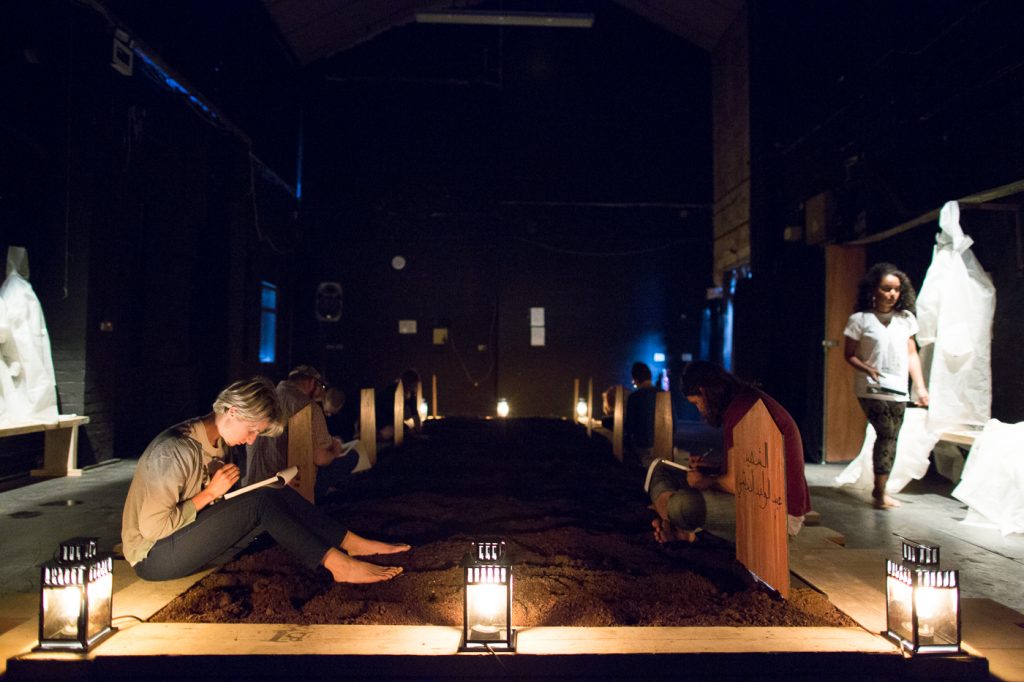‘Dit regiem heerst ook over je na je dood. Het regiem steelt je verhaal. Ze gebruiken je om hun eigen verhaal te vertellen. Nabestaanden worden gedwongen om verklaringen te onderteken dat de dode is vermoord door de oppositie. Het regiem gebruikt de doden om de levenden te onderdrukken.’ De Libanese kunstenares Tania El Khoury heeft een statement gemaakt: Gardens Speak (Tuinen Spreken). Een installatie, een immersieve[hints]definitie: onderdompelend, waardoor je de echte wereld om je heen vergeet.[/hints] voorstelling, waarin de toeschouwers zelf acteur zijn. Een voorstelling die bestaat uit een berg aarde waaruit zacht stemmen klinken vanonder grafstenen. Die voorstelling komt in juni naar Amsterdam, als een van de voorbeelden van de nieuwe Holland Festival-programmering door festivaldirecteur Ruth MacKenzie.
De berg aarde waarin en waarop de installatie zich afspeelt staat voor de vele duizenden anonieme achtertuingraven in Syrië. In het begin van de Syrische burgeroorlog was de strijd nog vooral een strijd tussen tegenstanders van de dictatuur van president Assad en diens (geheime) politie. De eerste slachtoffers waren vaak nog gewoon studenten die meededen aan vreedzame demonstraties, die pamfletten uitdeelden, of die de begrafenis van een vriend bezochten. Immers: het bombarderen van begrafenisplechtigheden was en is een beproefde methode van moorddadige regiems en misdaadsyndicaten om opstandige netwerken uit te schakelen.
Tania El Khoury hoorde in 2013 van het Syrische alternatief: de privébegrafenis in eigen achtertuin, of bij gebrek daaraan in een anoniem stadspark, zonder grafsteen of herdenkingsplek. Zo’n actie is zowel een uiting van angst als een daad van verzet: dit zijn doden die de regering niet meer kan misbruiken. ‘Het stuk is oorspronkelijk ook niet bedoeld voor het Europese publiek. Het is in Libanon gemaakt en de tekst was ook in het Arabisch. Het laatste waar ik aan dacht was het Europese publiek. Het idee was om de naamloze doden een graf te geven, met mooi gekalligrafeerde letters erop. In het echt zijn veel van deze mensen zonder grafsteen begraven, anoniem. Ik wilde het daarna in andere talen doen, met andere grafstenen, en steeds weer de lokale aarde. Elk land heeft andere aarde, tenslotte.’
Waar komt het idee vandaan om letterlijk te graven naar het verhaal, op een bijna echte begraafplaats?
‘‘Het uitgangspunt is het geluid. Je moet alert worden op wat je hoort. Het idee was: waar je ook bent op de wereld, je zult de doden horen spreken als je je oren tegen de grond houdt. Toen we eenmaal met de vormgeving bezig waren, ontdekte ik dat het effectiever zou zijn als mensen er echt actief mee bezig zouden moeten gaan, door zelf te gaan graven. En als je er dan van boven naar kijkt, lijkt het ook of de toeschouwers in hun witte pakken zelf de doden zijn, die daar liggen. Zodra ze dan weer hun beschermende kleren uit doen en die briefjes gaan schrijven, veranderen ze weer in de bezoekende nabestaanden.’’

Na afloop mag je als toeschouwer een brief schrijven aan de dode die je zojuist hebt aangehoord. Wat gebeurt er met die briefjes?
‘‘Oorspronkelijk was het de bedoeling om een paar van die verhalen te delen met de mensen die ze ons hadden verteld: nabestaanden, vrienden. Maar ik vind dat moeilijk. Niet alleen omdat het vaak heel persoonlijke boodschappen zijn, mensen stoppen er echt hun ziel in. Dus het is ook te moeilijk om ze met de nabestaanden te delen: ze zijn te persoonlijk. Ik heb wel een paar van die briefjes gebruikt in een boek dat ik over dit project heb gemaakt. Ik houd ook van die brieven als object. Je kunt zien dat ze onder de aarde hebben gelegen. Misschien zal ik ze nog eens exposeren, zodat mensen ze kunnen zien.’
‘In die briefjes praten mensen ook meer over zichzelf dan over de dode. Ze schrijven bijvoorbeeld: ik weet niet of ik in jouw schoenen zo dapper was geweest. Of ‘Je bent even oud als ik’. Ik vind dat heel mooi. Maar er spreekt ook van een gevoel van machteloosheid uit: de pijn is te groot.’’
In Nederland, eerst in Rotterdam (Rabih Mroué), en later ook in het Holland Festival (Walid Raad), zijn een paar keer Libanese kunstenaars op bezoek geweest, met voorstellingen die meer documentair dan theatraal van karakter waren. Soms waren het niet meer dan powerpoint presentaties, maar dan wel heel speciale. Plaats jij jezelf ook in deze traditie van Libanees documentair theater?
‘De naoorlogse[hints]De Libanese Burgeroorlog (Arabisch: الحرب الأهلية اللبنانية , Al-Ḥarb al-Ahliyyah al-Libnāniyyah) was een burgeroorlog in Libanon van 13 april 1975 tot 13 oktober1990 die resulteerde in de dood van ongeveer 250000 mensen. Ten gevolge van deze burgeroorlog sloegen bijna één miljoen mensen uit Libanon op de vlucht.(bron: wikipedia)[/hints] kunstscene in Beiroet is erg bezig met het vertellen van de verzwegen verhalen. De Libanese oorlog is niet goed gedocumenteerd. Dus wat ik met die generatie kunstenaars gemeen heb, is dat we de geschiedenis willen vastleggen. Maar mensen als Walid Raad gebruiken fictie en zelfs leugens om de geschiedenis te vertellen, terwijl ik me met zuivere ‘oral history’ bezighoud. Alles wat ik doe is de waarheid. En ik wil het letterlijk tastbaar maken. Dat gaat dus verder dan beeldende kunst.’
Geluid is essentieel in de voorstelling. Sterker nog: de voorstelling is geluid. Dankzij dat geluid kun je niet anders dan meegaan met het verhaal. Dat is sterker dan video.
‘Ik zie dit soort interactieve, immersieve kunst als een politiek middel Door er zo in te moeten duiken word je gedwongen stelling te nemen. Je kunt niet passief blijven. Ik kies ook duidelijk partij. Dit werk gaat over de allereerste dagen van de opstand, die toen echt een opstand was van mensen die zich verzetten tegen 40 jaar van onderdrukking. Nu vergeten we dat, omdat we een enorme burgeroorlog zien. Maar we mogen niet vergeten dat het met die oprechte opstand begonnen is.’
